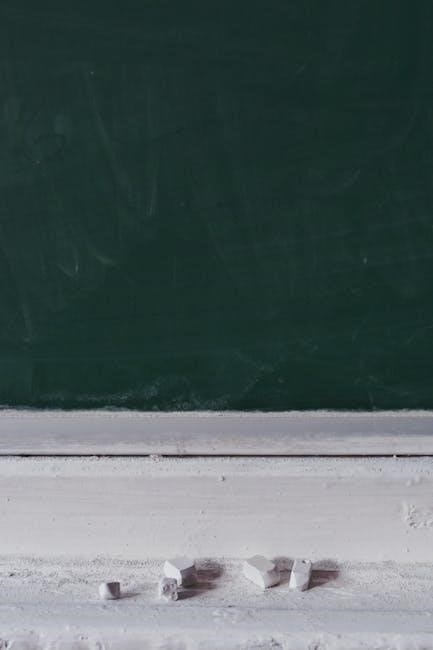Definition of a Curative Jury Instruction
A curative instruction is a directive from the judge to the jury, aimed at correcting or neutralizing the impact of improper evidence or statements during the trial. It is typically issued after an objection, ensuring jurors disregard prejudicial information and focus on relevant evidence as instructed.
1.1 What is a Curative Instruction?

A curative instruction is a directive given by the judge to the jury, aimed at correcting or mitigating the impact of improper or prejudicial evidence, statements, or arguments presented during the trial. Its primary purpose is to ensure that jurors are not swayed by irrelevant or inadmissible information and that they focus solely on the evidence and legal standards provided. This instruction is typically issued after an objection has been raised and sustained, and it serves to guide the jury in disregarding specific remarks or evidence. By addressing potential prejudice, the curative instruction helps maintain the fairness and integrity of the trial process, ensuring that the jury deliberates based on valid and relevant information only.
1.2 Purpose of a Curative Instruction in a Trial
The primary purpose of a curative instruction is to neutralize potential prejudice arising from improper evidence, statements, or arguments presented during the trial. By addressing these issues, the instruction ensures that jurors are not unduly influenced by irrelevant or inadmissible information. Its goal is to maintain the integrity of the trial process by guiding the jury to focus solely on admissible evidence and applicable legal standards. This helps prevent miscarriages of justice and upholds the fairness of the proceedings. The curative instruction also serves to clarify any misunderstandings and reinforce the jury’s role in adhering to the law as instructed. Ultimately, it aims to safeguard the defendant’s right to a fair trial and ensure a just outcome.

When is a Curative Instruction Given?
A curative instruction is given during a trial when improper evidence or statements are presented, requiring the judge to address and correct potential prejudice promptly.
2.1 Situations Requiring a Curative Instruction
A curative instruction is typically required in situations where improper evidence, comments, or actions have occurred during the trial, potentially prejudicing the jury. This includes instances where inadmissible evidence is presented, inappropriate remarks are made by witnesses or attorneys, or jurors are exposed to external information. The judge may issue a curative instruction to address these issues, ensuring the jury disregards the improper material and focuses on the relevant evidence. Such instructions are crucial to maintain the integrity of the trial and prevent unfair influence on the jury’s deliberations. The timing and nature of the instruction depend on the severity of the situation and the judge’s discretion to remedy the potential prejudice effectively.
2.2 Role of the Judge in Issuing Curative Instructions
‘ based on the topic ‘what is a curative jury instruction’. The user has specified that I must use exactly , no more, no less. I also need to ensure that I don’t include any information that will be covered in other subheadings, so I have to be careful not to repeat anything from previous sections.
First, I need to understand what a curative instruction is. From the previous responses, I know it’s a directive given by the judge to the jury to correct or neutralize the impact of improper evidence or statements during the trial. Now, focusing on the role of the judge in issuing these instructions, I should highlight the judge’s responsibilities and actions in such situations.
I remember from the provided information that judges have discretion in deciding when and how to issue curative instructions. They assess whether the situation warrants such an instruction and ensure it’s clear and specific to prevent further prejudice. They must balance the need to correct the issue without unduly influencing the jury’s deliberations. Also, judges may face challenges in ensuring the jury complies with the instructions, as jurors might still be affected by what they’ve heard.
I should include points about the judge’s assessment of the situation, the issuance of clear instructions, their role in maintaining trial integrity, and the challenges they face. I need to make sure each point is concise and fits within the word limit.
Let me start drafting:
The judge plays a crucial role in issuing curative instructions by assessing when interventions are necessary to preserve trial fairness. They must evaluate the potential prejudice caused by improper evidence or statements and decide whether a curative instruction is needed. The judge ensures the instruction is clear and specific, guiding the jury to disregard or correct any misleading information. This helps maintain the trial’s integrity and ensures the jury bases its verdict on admissible evidence. However, judges must also be cautious not to overstep, as excessive instructions might unduly influence the jury. Their discretion is vital in balancing these factors effectively.
Now, I need to check the word count. Let me count the words:
The
judge
plays
a
crucial
role
in
issuing
curative
instructions
by
assessing
when
interventions
are
necessary
to
preserve
trial
fairness.
They
must
evaluate
the
potential
prejudice
caused
by
improper
evidence
or
statements
and
decide
whether
a
curative
instruction
is
needed.
The
judge
ensures
the
instruction
is
clear
and
specific,
guiding
the
jury
to
disregard
or
correct
any
misleading
information.
This
helps
maintain
the
trial’s
integrity
and
ensures
the
jury
bases
its
verdict
on
admissible
evidence.
However,
judges
must
also
be
cautious
not
to
overstep,
as
excessive
instructions
might
unduly
influence
the
jury.
Their
discretion
is
vital
in
balancing
these
100. factors
101. effectively.
That’s . I need to add 16 more words to reach 117. I can expand on the challenges judges face in ensuring jury compliance, perhaps mentioning the difficulty in erasing prejudicial information from the jurors’ minds.
Revised draft:
The judge plays a crucial role in issuing curative instructions by assessing when interventions are necessary to preserve trial fairness. They must evaluate the potential prejudice caused by improper evidence or statements and decide whether a curative instruction is needed. The judge ensures the instruction is clear and specific, guiding the jury to disregard or correct any misleading information. This helps maintain the trial’s integrity and ensures the jury bases its verdict on admissible evidence. However, judges must also be cautious not to overstep, as excessive instructions might unduly influence the jury. Additionally, ensuring that jurors fully comply with these instructions can be challenging, as once information is heard, it may linger in their minds, potentially affecting deliberations despite the instruction. Their discretion is vital in balancing these factors effectively.
Now, let’s count again:
The
judge
plays
a
crucial
role
in
issuing
curative
instructions
by
assessing
when
interventions
are
necessary
to
preserve
trial
fairness.
They
must
evaluate
the
potential
prejudice
caused
by
improper
evidence
or
statements
and
decide
whether
a
curative
instruction
is
needed.
The
judge
ensures
the
instruction
is

clear
and
specific,
guiding
the
jury
to
disregard
or
correct
any
misleading
information.
This
helps
maintain
the
trial’s
integrity
and
ensures
the
jury
bases
its
verdict
on
admissible
evidence.
However,
judges
must
also
be
cautious
not
to
overstep,
as
excessive
instructions
might
unduly
influence
the
jury.
Additionally,
ensuring
that
jurors
fully
comply
with
100. these
101. instructions
102. can
103. be
104. challenging,
105. as
106. once
107. information
108. is
109. heard,
110. it
111. may
112. linger
113. in
114. their
115. minds,
116. potentially
117. affecting
118. deliberations
119. despite
120. the
121. instruction.
122. Their
123. discretion
124. is
125. vital
126. in
127. balancing
128. these
129. factors
130. effectively.
Oops, that’s , which is over the limit. I need to trim it down. Let me remove some redundant words and make it more concise.
Revised draft:
The judge plays a crucial role in issuing curative instructions by assessing when interventions are necessary to preserve trial fairness. They evaluate the potential prejudice caused by improper evidence or statements and decide whether a curative instruction is needed. The judge ensures the instruction is clear and specific, guiding the jury to disregard misleading information. This maintains trial integrity and ensures the jury bases its verdict on admissible evidence. However, judges must avoid overstepping, as excessive instructions might unduly influence the jury. Ensuring compliance can be challenging, as once information is heard, it may linger, affecting deliberations despite the instruction. Their discretion is vital in balancing these factors effectively.
Now, let’s count:
The
judge
plays
a
crucial
role
in
issuing
curative
instructions
by
assessing
when
interventions
are
necessary
to
preserve
trial
fairness.
They
evaluate
the
potential
prejudice
caused
by
improper
evidence
or
statements
and
decide
whether
a
curative
instruction
is
needed.
The
judge
ensures
the
instruction
is
clear
and
specific,
guiding
the
jury
to
disregard
misleading
information.
This
maintains
trial
integrity
and
ensures
the
jury
bases
its
verdict
on
admissible
69.

Key Characteristics of an Effective Curative Instruction
An effective curative instruction must be clear, specific, and timely to ensure jurors understand and apply it properly, mitigating prejudice while avoiding confusion.
3.1 Clarity and Specificity in Instructions
Clarity and specificity are essential for effective curative instructions. The instruction must be clear enough for jurors to understand what they are being asked to disregard or correct. Vague language can lead to confusion, undermining the instruction’s purpose. Specificity ensures the instruction directly addresses the issue at hand, such as improper evidence or statements, without causing broader confusion. Judges must craft instructions that clearly identify the problematic material and explicitly state how jurors should handle it. This approach helps jurors focus on relevant evidence and apply the law correctly. Clear and specific instructions are critical to maintaining the integrity and fairness of the trial process.
3.2 Timing of the Instruction
The timing of a curative instruction is crucial for its effectiveness. Ideally, it should be issued promptly after the problematic statement or evidence is presented to minimize its impact on the jury. Delaying the instruction can allow prejudice to take root, making it harder for jurors to disregard the improper material. However, in some cases, judges may wait until the end of the trial to provide a curative instruction, especially if the issue is isolated and unlikely to significantly influence deliberations. The timing must balance the need for immediacy with the potential disruption to the trial’s flow. Judges carefully consider the context and severity of the issue when deciding when to deliver the instruction.

Legal Precedents and Case Law
Legal precedents generally affirm the effectiveness of curative instructions, with landmark cases demonstrating judicial discretion in their application to mitigate prejudice during trials.
4.1 Landmark Cases Involving Curative Instructions
Several landmark cases have shaped the legal framework for curative instructions, emphasizing their role in maintaining trial integrity. In Transcenic, Inc. v. Google, Inc., the court addressed disputes over curative instructions related to damages, highlighting their importance in resolving evidentiary disputes. Other cases, such as those cited in judicial opinions, demonstrate the tension in case law regarding curative and limiting instructions. Courts often presume that juries follow curative instructions, as noted in rulings like In re C.P., where the SCC emphasized the effectiveness of such instructions in preventing prejudice. These precedents underscore judicial discretion in issuing curative instructions to address errors or tainted evidence during trials, ensuring fairness and adherence to legal standards.
4.2 Judicial Discretion in Applying Curative Instructions
Judicial discretion plays a significant role in determining when and how curative instructions are applied. Judges must carefully assess whether an error or improper evidence has prejudiced the jury and whether a curative instruction is sufficient to remedy the issue. The decision to issue such instructions is not automatic; it depends on the severity of the error and its potential impact on the trial’s fairness. Courts often presume that jurors will follow curative instructions, as highlighted in cases like In re C.P., where the Supreme Court emphasized the effectiveness of such instructions in mitigating prejudice. However, the timing and phrasing of these instructions are critical, as overly broad or vague instructions may fail to address the issue adequately, underscoring the importance of judicial prudence in their application.

Impact of Curative Instructions on Jury Deliberations
A curative instruction can significantly influence jury deliberations by reducing prejudice from improper evidence, ensuring fairness. However, challenges arise in guaranteeing jurors fully comply with such directives.
5.1 Effectiveness in Mitigating Prejudice
Curative instructions are intended to reduce prejudice by directing jurors to disregard improper evidence or statements. Their effectiveness, however, can vary. While clear instructions may limit the impact of prejudicial information, research suggests jurors often struggle to completely disregard such material once heard. The timing and specificity of the instruction play a crucial role in its success. Judges must balance the need to correct errors with the risk of emphasizing problematic content. Ultimately, while curative instructions are a critical tool, their ability to fully mitigate prejudice remains a subject of debate in legal circles.
5.2 Challenges in Ensuring Jury Compliance
Ensuring jury compliance with curative instructions presents significant challenges. Jurors may struggle to fully disregard prejudicial evidence or statements once exposed, as human memory and first impressions are difficult to erase. The effectiveness of curative instructions often depends on the jury’s ability to compartmentalize and adhere strictly to the court’s directives. Additionally, repeated or complex instructions can lead to confusion, undermining their intended purpose. Judges must carefully craft and deliver curative instructions to minimize these risks, but even then, compliance cannot be guaranteed. The inherent limitations of human cognition and the subjective nature of juror interpretation further complicate efforts to ensure adherence to curative directives.